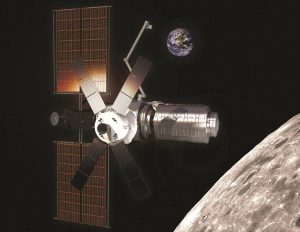Introduction to Deep Space Satellite Platforms
A deep space satellite platform serves as the core structure that supports long-duration missions beyond Earth’s orbit. Unlike satellites designed for low Earth orbits (LEO), these platforms are built to withstand the unique challenges of deep space, including extreme temperatures, vast distances, and long communication delays. With advancements in space exploration, the role of these platforms is becoming increasingly significant in missions such as Mars exploration, asteroid mining, and interplanetary communications.

Key Features of a Deep Space Satellite Platform
- Autonomy and Self-Management
In deep space, real-time communication with Earth can take several minutes or even hours, depending on the distance. As a result, a deep space satellite platform must be equipped with autonomous systems to handle routine operations, decision-making, and adjustments without immediate human intervention. This autonomy ensures that the platform can respond to unexpected conditions or system malfunctions. - Enhanced Propulsion Systems
Deep space missions require efficient propulsion systems to cover vast distances over long periods. Common propulsion methods include ion thrusters and chemical propulsion systems. The platform must also support trajectory correction maneuvers to ensure precise navigation, especially during interplanetary travel. - Durability and Radiation Protection
The harsh conditions of deep space expose satellites to intense radiation and extreme temperatures. The deep space satellite platform must be built with durable materials and advanced shielding techniques to protect its onboard systems and payload. Robust thermal control systems are also essential for maintaining operational temperatures. - Energy Management
Solar power is often used in LEO satellites, but deep space missions may face reduced sunlight. Thus, deep space satellite platforms are typically equipped with nuclear power sources or advanced battery systems to ensure consistent energy supply throughout the mission. Managing energy consumption efficiently is key for long-duration missions, especially when the satellite must operate far from the Sun.
Applications of Deep Space Satellite Platforms
- Interplanetary Exploration
Deep space satellite platforms play a crucial role in interplanetary exploration missions. These platforms support spacecraft that travel to planets like Mars, Jupiter, and beyond. They house scientific instruments, cameras, and communication systems needed to collect and transmit valuable data back to Earth. - Asteroid and Comet Missions
With growing interest in asteroid mining and scientific studies of comets, deep space satellite platforms serve as the foundation for these missions. They enable long-term orbiting and close observation of celestial bodies, providing critical data for resource assessment or planetary defense studies. - Space Communication Networks
As human exploration moves deeper into space, reliable communication becomes a critical challenge. Deep space satellite platforms are increasingly being used to create communication relay networks, ensuring continuous contact between Earth and distant missions. These platforms are designed to facilitate high-data-rate transmissions over vast distances.
Challenges Faced by Deep Space Satellite Platforms
- Extended Mission Durations
Deep space missions often span several years or even decades. A deep space satellite platform must be engineered for longevity, capable of withstanding prolonged exposure to the vacuum of space, micrometeoroid impacts, and system degradation over time. Building such durable systems requires careful selection of components and materials. - Distance and Communication Delays
One of the main challenges in deep space missions is the significant communication delay. For example, signals from Mars can take between 4 to 24 minutes to reach Earth. Therefore, satellite platforms must rely on pre-programmed algorithms and artificial intelligence (AI) for decision-making when real-time commands are not feasible. - Power Limitations in Deep Space
As missions venture farther from the Sun, generating and storing enough power becomes a challenge. Deep space satellite platforms must balance power usage efficiently, prioritizing essential functions like communication and propulsion while conserving energy for long-term operation.
Deep Space Versus Low Earth Orbit Platforms
While both types of satellite platforms serve critical roles in space missions, there are significant differences in their design and capabilities. Low Earth Orbit platforms focus on missions like Earth observation, telecommunications, and satellite-based internet services, where proximity to Earth allows for frequent communication and energy from solar panels is abundant. In contrast, deep space satellite platforms are designed to handle greater autonomy, reduced sunlight, and longer mission durations. These platforms require more advanced propulsion and navigation systems, as well as enhanced durability against the extreme conditions of space.
Future Developments in Deep Space Platforms
With the rise of missions targeting Mars, asteroids, and even deep-space human exploration, future deep space satellite platforms will incorporate more sophisticated technologies. Innovations in nuclear-powered propulsion, AI-driven autonomy, and modular design will enable satellites to undertake even more complex missions. The ability to adapt to various mission types, from planetary research to communication networks, will be a key focus of the next-generation platforms.
Additionally, as space agencies and private companies collaborate on deep space missions, cost-efficient satellite platforms will become essential to reduce the financial burden of exploration. Modular designs will allow for the reuse and reconfiguration of satellite components, further enhancing the sustainability of space exploration.
The Role of Deep Space Satellite Platforms in Human Space Exploration
As human space exploration becomes more ambitious, with plans for Mars colonization and lunar bases, deep space satellite platforms will play an indispensable role. These platforms will support continuous communication between Earth and astronauts, provide critical navigation data, and enable remote monitoring of space habitats and equipment. The adaptability and resilience of these platforms will determine the success of long-term human presence in space.
A deep space satellite platform is the technological foundation that enables space missions beyond Earth’s orbit. From supporting interplanetary exploration to ensuring reliable communication over vast distances, these platforms are essential for the future of space exploration. As new missions continue to push the boundaries of human knowledge, the development of advanced deep space platforms will be key to unlocking the secrets of our solar system and beyond.
